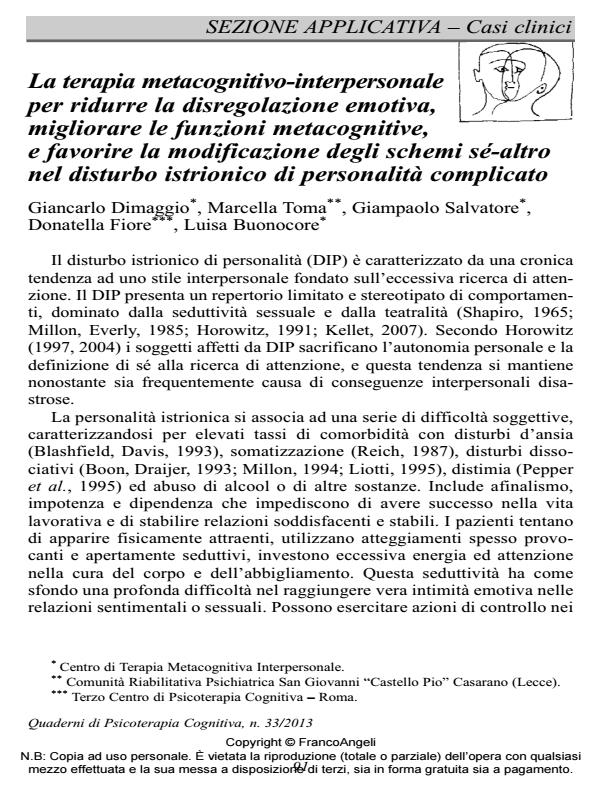Metacognitive Interpersonal Therapy for reducing emotional dysregulation, improving metacognition and promoting change in maladptive schemas in complex histrionic personality disorder
Journal title QUADERNI DI PSICOTERAPIA COGNITIVA
Author/s Giancarlo Dimaggio, Marcella Toma, Giampaolo Salvatore, Donatella Fiore, Luisa Buonocuore
Publishing Year 2013 Issue 2013/33
Language Italian Pages 23 P. 91-113 File size 166 KB
DOI 10.3280/QPC2013-033007
DOI is like a bar code for intellectual property: to have more infomation
click here
Below, you can see the article first page
If you want to buy this article in PDF format, you can do it, following the instructions to buy download credits

FrancoAngeli is member of Publishers International Linking Association, Inc (PILA), a not-for-profit association which run the CrossRef service enabling links to and from online scholarly content.
Compromised capacities to make sense of both one’s own and the others’ mental states and to integrate different states in a coherent self-representation, that is metacognition, are key features of Histrionic Personality Disorder. Other problems are emotional dysregulation and maladaptive interpersonal schemas. These problems are even more severe when other traits such as Borderline or Narcissistic ones co-occurr. In order to be effective psychotherapy must deal with all these problems. In this work we describe the steps of individual psychotherapy during hospitalizations of a young woman suffering from both Histrionic and Borderline personality disorders with narcissistic traits. Patient has been treated with Metacognitive Interpersonal Therapy. Therapy goals were: decreasing emotional dysregulation; b) improving metacognition in order to foster a better quality of interpersonal relationships. Outcome was good. We discuss implications for applying Metacognitive Interpersonal Therapy to personality disorders of the dramatic cluster.
Keywords: Histrionic personality disorder, therapy relationship, metacognition, interpersonal schemas.
Giancarlo Dimaggio, Marcella Toma, Giampaolo Salvatore, Donatella Fiore, Luisa Buonocuore, La terapia metacognitivo-interpersonale per ridurre la disregolazione emotiva, migliorare le funzioni metacognitive, e favorire la modificazione degli schemi sé-altro nel disturbo istrionico di personalità complicato in "QUADERNI DI PSICOTERAPIA COGNITIVA" 33/2013, pp 91-113, DOI: 10.3280/QPC2013-033007